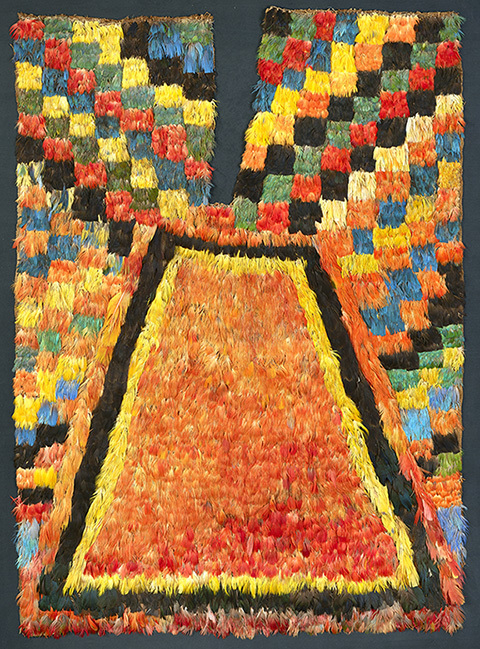Angel with a Checkered Mantle
Altiplano, Peru, Seventeenth Century
Angel with a Checkered Mantle, Altiplano, Peru, Seventeenth Century
Oil on fabric, 64 ½ x 48 ½ inches (168.83 x 123.19 cm)
Jay I. Kislak Collection of the Early Americas, Exploration and Navigation, MDC PC 2020.3.10
The remarkable paintings of angels created in the Viceroyalty of Peru display highly, original iconography, beautiful garments of lace and brocade, jewels, feathered hats and wings, halberds, and shields. Their fancy clothing derived from that of criollo and Andean nobles and aristocrats. While inscriptions on many of these paintings give us the names of the angels, the identity of others may be suggested only by their costumes and accessories. This angel wears a plumed hat and holds a scepter or weapon; the chape of a sword’s scabbard peeks out behind him, ready for action. The painting entered the collection at MDC identified as the Archangel Hadriel, but he resembles similar depictions designated as the Archangel Gabriel. The Angel of Mercy, Guardian of the Celestial Treasury, and chief messenger of God the Father, Gabriel is a popular figure in Christian art, most often appearing in the Annunciation of Mary as a beautiful young man, richly dressed in a multicolored cape and elaborate feathered wings, as he is in this painting.
Here, in an especially unique addition to traditional representations, the cape folded over his arm bears a beautiful checkerboard pattern, which we can associate directly with the featherwork of the indigenous Andean people. Checkerboard patterns appeared for centuries in Andean art, and are particularly prominent in Nazca textiles and featherwork, and in Inca tunics. Checkerboards seen in the decorative geometric motifs of tocapus—a glyph-like symbolic language used throughout the Inca Empire on textiles, ceramics, and metalwork—are believed to have been warrior emblems. The Jay. I. Kislak Collection holds a number of feathered textiles, including the Nazca tunic pictured below, that feature the checkerboard pattern.

Soldier angels enjoyed widespread popularity throughout the Altiplano of Peru and Bolivia, perhaps because they captured the imagination of the indigenous people searching for protection, who may also have identified them with the Andean birds and winged warriors from the pre-Hispanic pantheon that were seen as mediators between this world and the spirit realm. In the Christian tradition, angels are considered messengers of God, who serve as intermediaries between Heaven and Earth. Among the highest-ranking angels, archangels have authority over other angels. According to several religious traditions, God created seven archangels to fulfill specific purposes. Each has a special duty, such as bearing messages, providing protection, healing, or guiding souls. Their portrayals in Viceregal art include specific attributes associated with their roles in Catholic liturgy.
Prints by Flemish engraver Hieronymous (Jerome) Wierix depicting the seven archangels—who are enumerated in the apocryphal Book of Enoch—may have circulated throughout the Andes in the seventeenth century and inspired the paintings. European prints were widespread in the Americas because they were cost-effective and easily distributed. The attire, names, and poses of Andean angels, however, separate such depictions from their sources in European prints, making them specifically American.
A wide variety of paintings of angels, uniquely interpreted by indigenous artists in local workshops, were sold throughout the Viceroyalty. Some canvases feature angels holding harquebuses (angeles arcabuceros), an early muzzle-loaded firearm, instead of the sword or staff traditionally wielded by martial angels, such as those in the two examples in the Jay I. Kislak Collection.
Exhibited: Culture and Change in the Early Americas, Kislak Center, Miami Dade College, May 20, 2018–January 31, 2021.
Photos by Lynton Gardiner. © Kislak Center at MDC.
